This project is made possible through the partnership of WATER CHARITY and the NATIONAL PEACE CORPS ASSOCIATION.
This project has been completed. To read about the conclusion, scroll down the page.
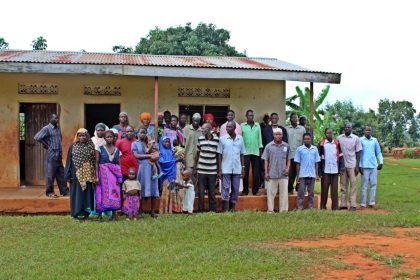
Location
Mayuge District, Busoga Region, Uganda
Community Description
Busoga district. Mayuge town is still quite rural, even by Ugandan standards. While it is mid-sized, it is off the main road and thus there is a strong community feel, as everybody knows one another.
Problem Addressed
Bugadde SACCO, is the largest savings and credit cooperative in Eastern Uganda with over 20,000 active members, with over 85% engaged in agriculture.
Over the past few years, they have noticed lower average savings balances and increasing default rates on loans as the business of farming has become significantly more difficult. Largely as a result of climate change, farmers are unable to plan effectively and often suffer from poor harvests as a result of extreme weather conditions.
Heretofore, Bugadde SACCO has primarily sought to combat this issue through teaching lessons in financial literacy and through adjusting its savings and loan products to allow for increased flexibility. However, there is a pressing need to target the issue at its source: Simply put, their members must adapt to climate change if they are to survive.
Interviews with current members working as farmers show that the largest obstacle to managing their businesses under current conditions is the inability to control water flow. Farmers lack the ability to harvest water during heavy rainfalls, as well as the ability to effectively distribute this water to their crops.
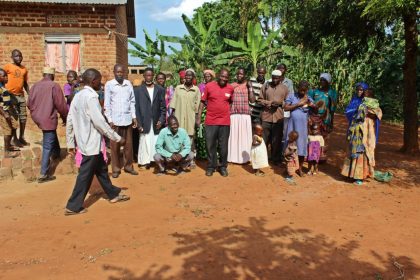
Project Description
This project is to build rainwater catchment systems in 3 separate communities sufficient to provide for the irrigation of all the farms.
This project will provide members with the materials and training needed to build storage tanks and an accompanying irrigation system to irrigate two acres of farmland.
The systems will be constructed using commonly-found building materials, such as bricks, sand, cement, concrete, pipes, iron bars, wire mesh, hardenproof, binding wire, nails, etc.
The system design was originally drafted by an Agricultural Extension Officer working with the SACCO, and was refined and improved upon during the first construction project in February.
We will be working with a local engineer to construct the next three tanks. Water Charity funds will also provide each group with a solar-powered water pump and distribution system (maybe drip irrigation, hose, or another mechanism, depending on the primary crops farmed by each group).
The community is the driving force behind the project. Bugadde SACCO plans to sponsor the event by providing tents and other support – e.g. helping to negotiate the contract for skilled labor, aiding in the procurement of materials as necessary. Together with the membership, Bugadde SACCO staff will also help construct the tanks themselves (as well as provide supportive labor, such as cooking for participants during the construction process). However, the construction process will be spearheaded by the communities benefiting from the tanks. This serves the dual purpose of fostering ownership over the final product and ensuring that participants – including visiting participants from other regions – can replicate the process in the future on another farmland.
Water Charity funds will be used for hiring a team of community members with specialized skills to perform technical aspects of the building process that cannot be performed by most community members (e.g. brick-laying); however, the community at large will be involved with all other aspects of the building process during the entirety of the construction period.
Construction sites will be selected based on several criteria including proven need (i.e. they have expressed in interviews that irrigation poses difficulty for them and specifically have voiced interest in building a tank), collective farming (thereby maximizing the number of people benefiting from a single constructed tank), and member activity (i.e. as this project requires members to provide labor, selected groups will be well-organized and skilled at member mobilization). We currently plan to work with members in the nearby villages of Kyette, Wankonge, and Itaka Ibolu.
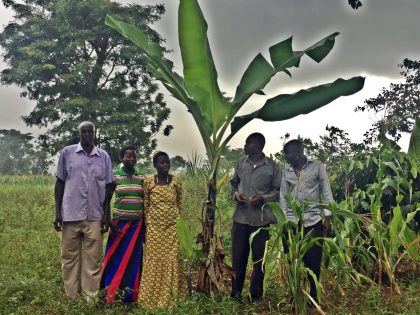
Project Impact
This project will benefit the residents of 3 communities, directly improving the livelihoods and lives of 300 people. Additional beneficiaries will include participants and trainees who learn the technology and apply it to their own projects.
Project Administration
Samantha Strimling, Peace Corps Volunteer
Monitoring and Maintenance
In the months following construction, Bugadde SACCO will monitor the use of the irrigation system and ensure it is serving its purpose. In particular, during the dry season, when the irrigation system will be most utilized in the absence of rain, Bugadde SACCO staff will measure crop yields. In this region of Uganda, farmers lack irrigation technology and typically farm only during the rainy season, thus any yields measured during the dry season will represent a dramatic improvement over prior periods.
However, going forward, the villages where the tanks are constructed will be expected to report yields each season to track progress over time. Each region selected has elected local leadership and currently meets at least monthly with Bugadde SACCO staff to receive lessons in agriculture and financial literacy, deposit savings, and pay off existing loans. Since Bugadde SACCO maintains regular relationships with these farmers, data collection will be easily accomplished.
Maintenance and small-scale repairs of the tanks, pumps, and other aspects of the system will be the responsibility of the community.
Let Girls Learn
While this project is not explicitly aimed at keeping girls in school, projects like these raise community income, making education more affordable. Additionally, in Uganda, farming obligations often prevent children from attending school. Therefore, projects that reduce farmers’ susceptibility to climate change, making them less exposed to the adverse effects of extreme and uncertain weather have the indirect effect of promoting education.
Project Funding
Please use this Donate button to contribute to the project. Funds raised in excess of the project amount will be allocated to other projects in Uganda.
Conclusion of Mayuge District Rainwater Harvesting Systems Project – Uganda
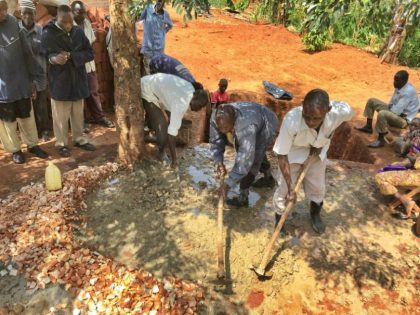
We completed the Mayuge District Rainwater Harvesting Systems Project – Uganda under the direction of Peace Corps Volunteer Samantha Strimling. The project was designed to build rainwater catchment systems in 3 separate communities.
Samantha reports:
Summary
This irrigation process has brought more meaning and satisfaction to my service than any work I have done previously or since. Each day of the process was a true community effort, and many anecdotes aptly paint that picture: women mixing cement with babies on their back; children pushing wheelbarrows of dirt to clear the area for building in Itaka Ibolu; children and older men joining together to push wheelbarrows of sand for mixing in Wankonge; dozens of community members lining up to move thousands of bricks from outside the tank-to-be to inside in assembly format; the building team teaching a half dozen women how to apply and smooth the plastering mixture (plastering sand, concrete, water) to the outside of the finished tank; young men mixing and carrying mortar for the bricks; women cooking for over a hundred community members in attendance to apply the final slab on the large tank and to watch the demonstration of the solar pump. The memories from this project are endless and I truly believe they will remain with me after service.
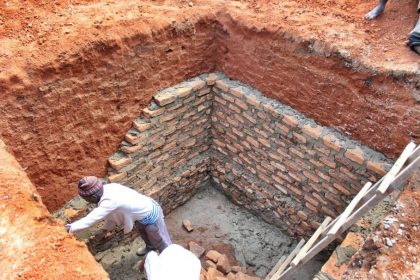
Additionally, what I am most proud of in accomplishing this project was my ability to take a backseat role throughout and trust the engineer and community members to mobilize participation, procure the building supplies, and ensure efficient and effective construction. My first year of service was spent intentionally building the skills (language, cultural adaptation, people management, etc.) in order to perform as an effective administrator, and this project showed me I have come a long way in that regard. I want to be regarding in my community as someone who initiates projects and marshals resources to enable community members to do what they want to do using the skills they already have. I felt I was able to do that throughout the course of this project and was extremely happy to play this role.
Goals Achieved
The initial goal of this project was to construct three irrigation systems — each complete with a small tank for filtration, a large tank for storing water, a solar-powered water pump, and a 100-meter hose. Not only was this goal met, but we were able to accomplish this ahead of schedule and below budget.
There was strong community buy-in, with 40-100+ people in attendance during each day of the building process. Mothers mixed cement with babies on their backs, children pushed sand in wheelbarrows and carried water from afar, and people of all ages helped with various tasks where possible, ranging from moving bricks to cooking posho. The success of this process brought home to me the importance of working closely with local partners. For each of the three systems, I was working with members of my organization who I knew well AND who had proved themselves to be active in saving and taking out loans to start projects, including collective projects.
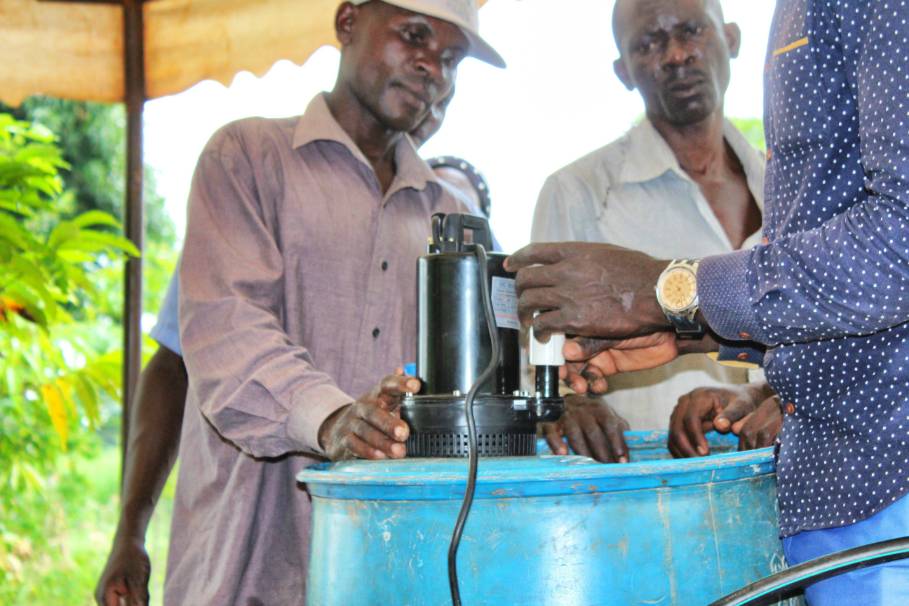
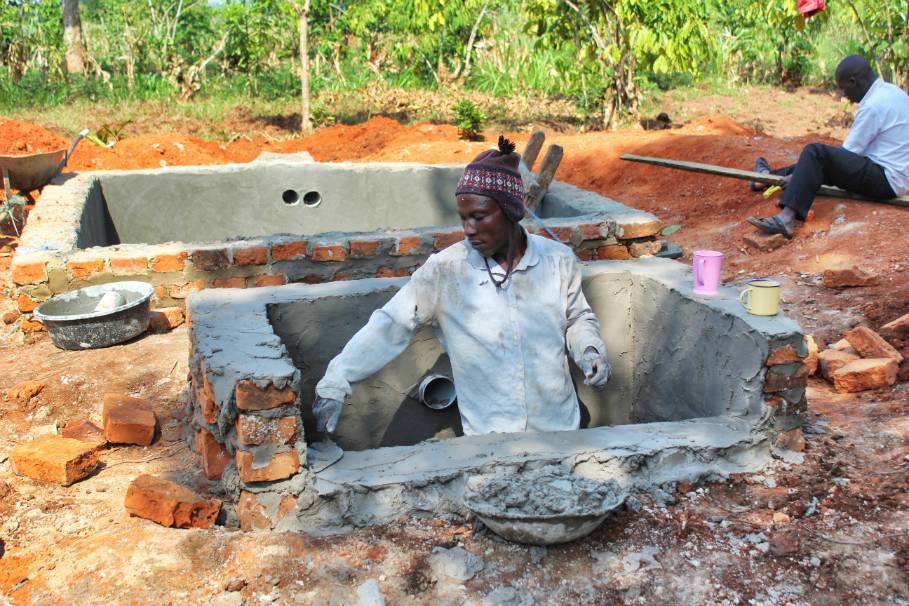
My organization is a credit union with over 20,000 members; to facilitate engagement with staff, the members are divided into groups, each of which elects a local chairman and secretary and decides on a monthly meeting time and place. For each group chosen for this project, both the chairman and secretary of the group were actively engaged in the community and well-respected. They expertly mobilized the community to participate in the project, adeptly handled procurement within the given budget and brought me receipts with minimal errors or need for additional explanation, and generally helped me coordinate the process.
Additionally, I worked with a local engineer who was knowledgeable, efficient, organized, and experienced. The communities in which I worked are extremely satisfied with the results. In particular, many members had an immensely positive reaction to the demonstration of the solar-powered pump (which I was able to trust the engineer to buy, negotiate the price, and train the members on how to use). The smoothness of this process has given me the confidence and knowledge to undertake similar efforts in other communities I work with going forward.
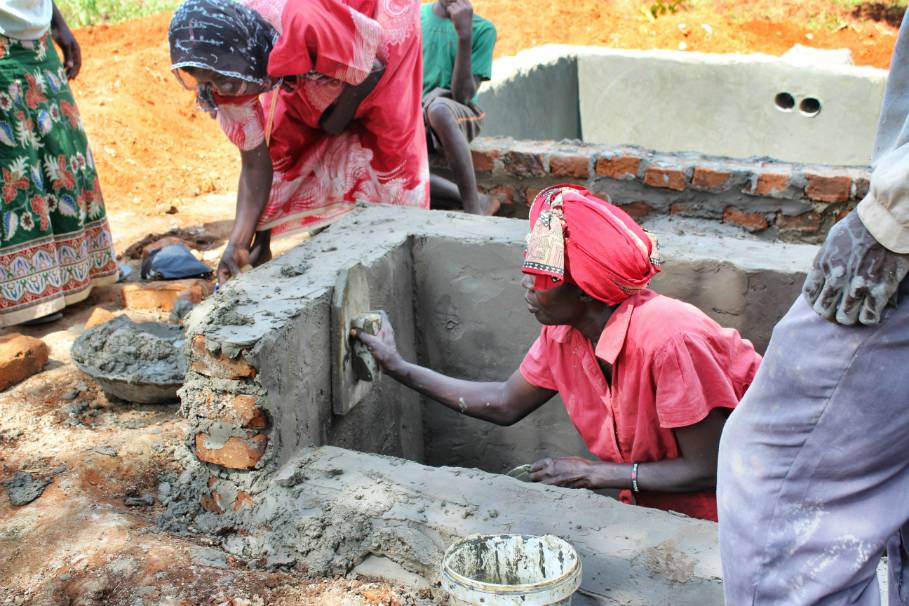
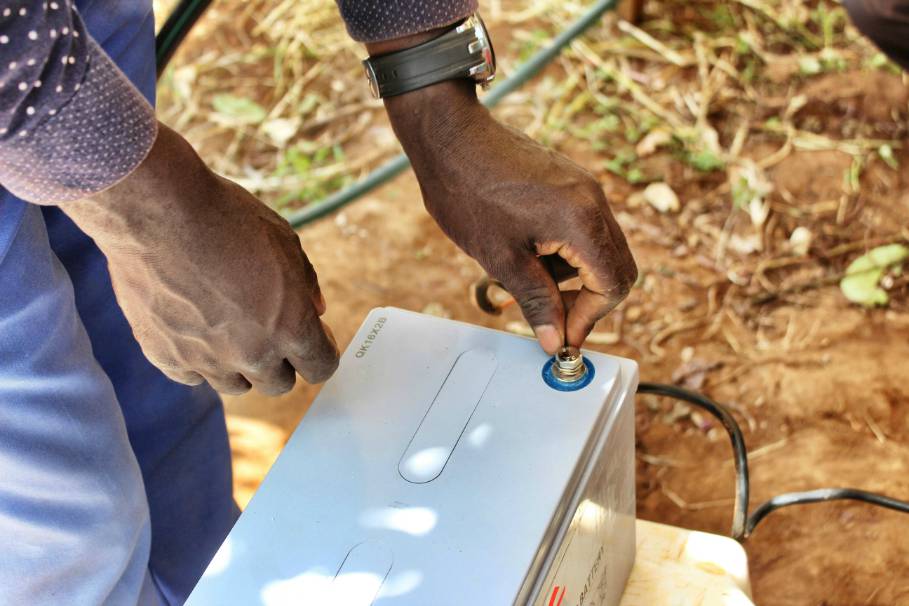
Capacity and Skills Built
One of the best parts of this project was the community involvement throughout the building process. Many people learned technical skills, such as plastering and bricklaying. Everyone saw, from start to finish, how each system was built. Additionally, all community members who want to use the pump (which depends on a stationary solar-panel for charging, but is portable) were required to attend an in-depth training on how to assemble, use, and care for the pump.
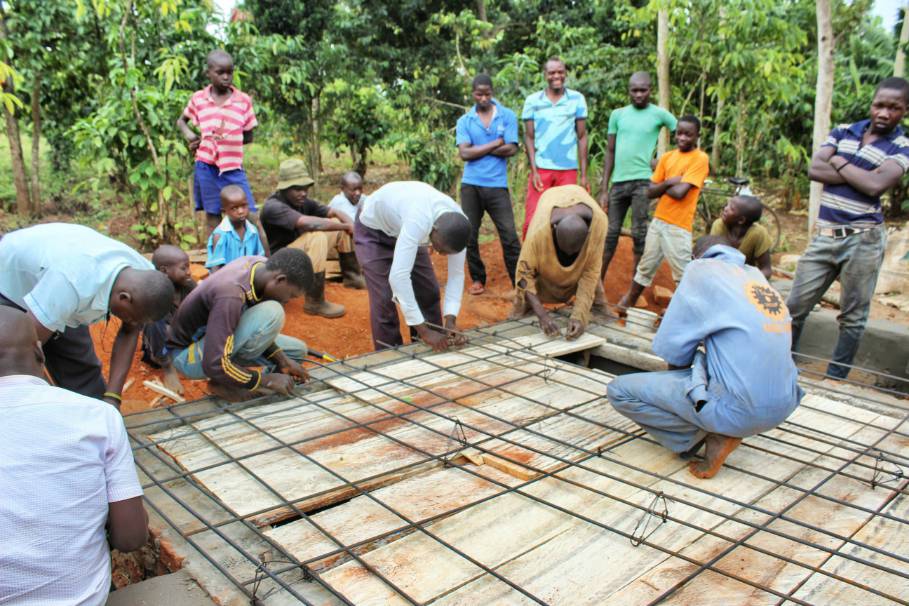
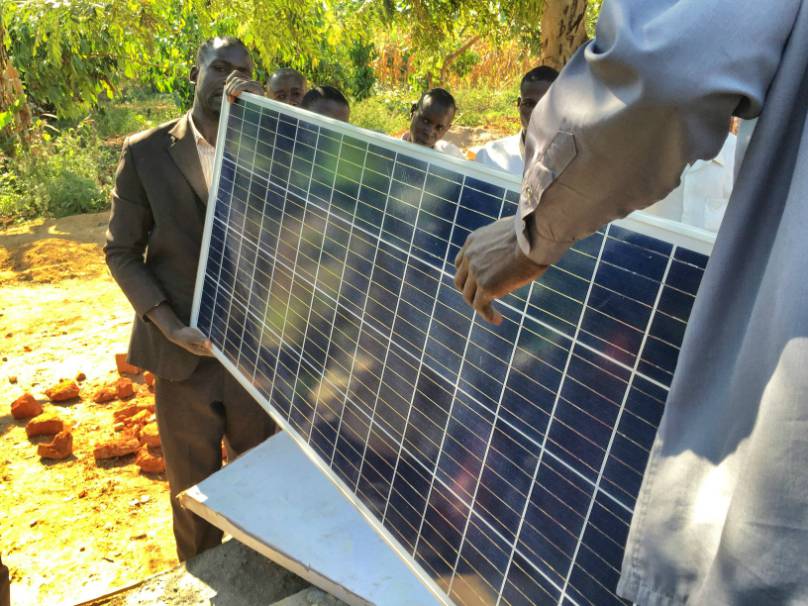
Sustainability
The primary benefit of this project is it will enable the farmers in the communities served to farm year-round and better navigate the intensity of irregularity of the environment, which has increased in recent years due to climate change. The structures built are permanent fixtures, which will last for many years. The solar pump will also last for several years to come (and even comes with a one year warranty). In fact, the main reason for buying solar-pumps, as opposed to the gas-powered pump purchased for the first system construction, is to increase the sustainability of the project. The solar-powered pump requires no money and minimal effort on the part of the farmer to continue usage.
Lessons Learned and Promising Practices
Many technical lessons (and related budgeting information) were learned throughout this process, which I will certainly apply if constructing irrigation systems for other farmers I work with. However, by far the most important take-away from this effort was the importance of working with a trustworthy team. My success was guaranteed by my great fortune to work with an extremely strong team of host country nationals. All parties were committed to a smooth process, displayed excellent communication, and fully bought-in to the importance of both the final result and a community-driven process. I am extremely proud of my ability to coordinate this process, particularly since no one I worked with spoke English and the entire process was conducted in the local language. However, this project drove home for me the importance of teamwork and empowering local partners to take the lead.
We are grateful to Samantha for completing this important project.